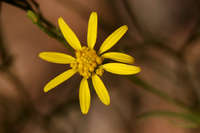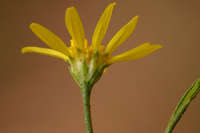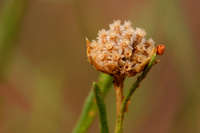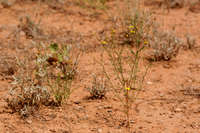|
|
|
|
Family: Asteraceae
roundleaf snakeweed
[Gutierrezia eriocarpa A.Gray, moreXanthocephalum sphaerocephalum (A. Gray) Shinners, Xanthocephalum sphaerocephalum var. eriocarpum (A.Gray) Shinners] |
Annuals, 20-50 cm. Stems minutely, prominently, often sparsely, papillate-scabrous (hairs triangular or deltate to lanceolate, less than 0.1 mm). Leaves: proximal usually absent at flowering; cauline blades 1-nerved, linear, 0.5-1.2 mm wide, little reduced distally. Heads in loose arrays. Involucres campanulate, 2.5-5 mm diam. Phyllary apices flat. Ray florets 10-15; corollas yellow, 3-5.5 mm. Disc florets 18-37. Cypselae 0.9-1.2(-1.4) mm, faces without oil cavities, densely strigoso-sericeous in rows (hairs appressed to spreading, apices clavate); pappi of 1 series of narrowly triangular or narrowly oblong scales 0.2-1 mm (distinct or basally connate 1 / 4 - 3 / 4 their lengths, usually shorter in rays). 2n = 8 (10). Flowering (Feb-)May-Dec. Grasslands, roadsides, lake edges, alkaline flats with Atriplex, oak-pine-juniper woodlands, often over gypsum or limestone; (200-)1300-2000 m; Ariz., N.Mex., Tex.; Mexico (Chihuahua, Coahuila, Durango, Nuevo León, San Luis Potosí, Tamaulipas, Zacatecas). Correll and Johnston 1970, Allred and Ivey 2012, FNA 2006 Duration: Annual Nativity: Native Lifeform: Forb/Herb General: Annual herbs, 2-60 cm tall; stems papillate-scabrous, much-branched in the upper two-thirds. Leaves: Alternate along the stems, the blades lance-linear, 1 mm wide and up to 3 cm long, 1-nerved, glabrous and glutinous. Flowers: Flower heads small, yellow, radiate, located at the tips of secondary branches; involucres broadly campanulate, 3-5 mm high, the bracts (phyllaries) in about 3 series, strongly graduated, straw-colored with a green tip; ray florets 10-20 per flower head, the laminae (ray petals) yellow, 3-5 mm long; disc florets 20-40 per flower head, yellow. Fruits: Achenes 1 mm long, densely strigoso-sericeous in rows; topped with a pappus of scales less than 1 mm high. Ecology: Found in calcareous, gypsum, and sandy soils in grasslands, along roadsides, in pinyon-juniper woodlands, and in alkalai flats, from 4,000-6,500 ft (1219-1981 m); flowers May to December. Distribution: TX, NM, and extreme se AZ; south to MEX Notes: This annual Gutierrezia is quite similar to G. texana, which is characterized by its smooth, hairless stems (G. sphaerocephala has papillate-scabrous stems) and by having fewer disc florets per flower head (10-20 compared to G. sphaerocephala's 20-40). Look for G. spaerocephala in calcareous and gypsum soils. Ethnobotany: Unknown Etymology: Gutierrezia is named for Pedro Gutierrez (Rodriguez), a 19th century Spanish noblemen and botanist; sphaerocephala comes from the Latin sphaero- or spherical, and cephala, or head. Synonyms: Xanthocephalum sphaerocephalum, Gutierrezia coulteri , Gutierrezia eriocarpa Editor: AHazelton 2017 |






